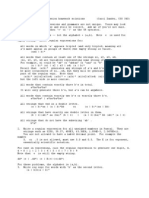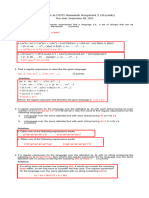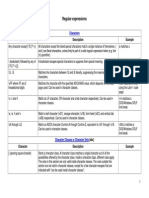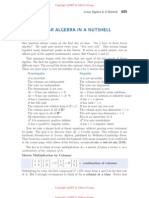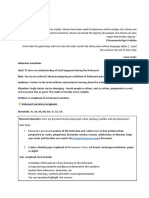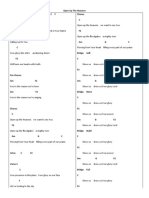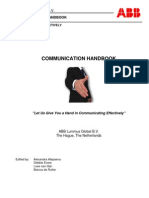Lex & Yacc
Lex & Yacc
Uploaded by
AGabriela PelayoCopyright:
Available Formats
Lex & Yacc
Lex & Yacc
Uploaded by
AGabriela PelayoOriginal Title
Copyright
Available Formats
Share this document
Did you find this document useful?
Is this content inappropriate?
Copyright:
Available Formats
Lex & Yacc
Lex & Yacc
Uploaded by
AGabriela PelayoCopyright:
Available Formats
Lex & Yacc
06/09/2011 11:16
Lex Practice
Metacharacter Matches
. \n * + ? ^ $ a|b (ab)+ "a+b" []
any character except newline newline zero or more copies of the preceding expression one or more copies of the preceding expression zero or one copy of the preceding expression beginning of line end of line
a or b
one or more copies of ab (grouping) literal "a+b" (C escapes still work) character class Table 1: Pattern Matching Primitives
Expression
Matches
abc abc* abc+ a(bc)+ a(bc)? [abc] [a-z] [a\-z] [-az] [ \t\n]+ [^ab] [a^b] [a|b] a|b
abc ab abc abcc abccc ... abc, abcc, abccc, abcccc, ... abc, abcbc, abcbcbc, ... a, abc
one of: a, b, c any letter, a through z one of: a, -, z one of: - a z
[A-Za-z0-9]+ one or more alphanumeric characters
whitespace anything except: a, b
a, ^, b a, |, b a, b
Table 2: Pattern Matching Examples
Regular expressions in lex are composed of metacharacters (Table 1). Pattern-matching examples are shown in Table 2. Within a character class normal operators lose their meaning. Two operators allowed in a character class are the hyphen ("-") and circumflex ("^"). When used between two characters the hyphen represents a range of characters. The circumflex, when used as the first character, negates the expression. If two patterns match the same string the longest match wins. In case both matches are the same length, then the first pattern listed is used.
http://epaperpress.com/lexandyacc/index.html Page 1 of 4
You might also like
- Course Challenge w5 3 CourseraDocument1 pageCourse Challenge w5 3 Courseraabdullahalmahmoodrakib0% (1)
- Math Review: a QuickStudy Laminated Reference GuideFrom EverandMath Review: a QuickStudy Laminated Reference GuideRating: 5 out of 5 stars5/5 (1)
- Regular Expression Homework SolutionsDocument2 pagesRegular Expression Homework Solutionscbt1402No ratings yet
- Matlab - Scilab EquivalentDocument87 pagesMatlab - Scilab Equivalentannatls100% (6)
- Ned Rorem As A Twentieth Century Song Composer (1965)Document251 pagesNed Rorem As A Twentieth Century Song Composer (1965)Miguel Campinho100% (2)
- Dark Eye - Aventurian BestiaryDocument130 pagesDark Eye - Aventurian BestiarylarlokNo ratings yet
- Internal Medicine RequirementsDocument226 pagesInternal Medicine Requirementsmanar100% (1)
- Regular Expression Cheat Sheet (Document2 pagesRegular Expression Cheat Sheet (andreluiz03No ratings yet
- Regular ExpressionDocument14 pagesRegular ExpressionVivek TgNo ratings yet
- CS375 Sol2 2023fDocument3 pagesCS375 Sol2 2023fSeung Jun LeeNo ratings yet
- Compiler Design Practical ListDocument5 pagesCompiler Design Practical ListSmruthi SuvarnaNo ratings yet
- Problem Description:: CSE420 (Compiler) Lab Assignment 3Document2 pagesProblem Description:: CSE420 (Compiler) Lab Assignment 3razzNo ratings yet
- RegexDocument20 pagesRegexoasisdesertNo ratings yet
- Regular Expression SyntaxDocument4 pagesRegular Expression SyntaxtomNo ratings yet
- Chemistry 1S - Prof Paul May: A Is A Constant. An Accurate Plot On Graph-Paper Is Not Required. (5 Marks)Document3 pagesChemistry 1S - Prof Paul May: A Is A Constant. An Accurate Plot On Graph-Paper Is Not Required. (5 Marks)masyuki1979No ratings yet
- A. Language of ExplanationDocument3 pagesA. Language of ExplanationshishirkholilNo ratings yet
- 2 Experiments, Incomplete Block Designs For 2 Experiments, Fractional 2 ExperimentsDocument50 pages2 Experiments, Incomplete Block Designs For 2 Experiments, Fractional 2 ExperimentsnidhiNo ratings yet
- Assignment (MODULE-1) : T 1:a? (B C) A T 2:b? (A C) B T 3:c ? (B A) C ' X? ' BbaacabcDocument2 pagesAssignment (MODULE-1) : T 1:a? (B C) A T 2:b? (A C) B T 3:c ? (B A) C ' X? ' BbaacabcAnsh KunduNo ratings yet
- Data Structures, Homework 5, AnswersDocument5 pagesData Structures, Homework 5, AnswersFirst DreamNo ratings yet
- Role of Lexical Analysis: ScanningDocument2 pagesRole of Lexical Analysis: ScanningKshitijKumarSinghNo ratings yet
- cs212 Lect02 63 InterDocument39 pagescs212 Lect02 63 InterLeng Hour lengNo ratings yet
- Lex AnalysisDocument13 pagesLex AnalysisAbhinit ModiNo ratings yet
- En Field Constraints 2013 20130801Document8 pagesEn Field Constraints 2013 20130801Luis Alberto Lamas LavinNo ratings yet
- Regular ExprDocument3 pagesRegular ExprChinmayee AravindNo ratings yet
- HW2 Solutions 2015 SpringDocument2 pagesHW2 Solutions 2015 SpringabrarNo ratings yet
- 2 Regular Expressions WorksheetDocument2 pages2 Regular Expressions WorksheetDheekshithaa SaravananNo ratings yet
- Tugas Bab 7Document3 pagesTugas Bab 7Esy Era SetyaniNo ratings yet
- Re and Finite Automata ExamplesDocument6 pagesRe and Finite Automata ExampleshhhNo ratings yet
- Regular ExpressionsDocument4 pagesRegular Expressionssriramdangeti100% (2)
- Lecture 7 Regular Languages and Its PropertiesDocument70 pagesLecture 7 Regular Languages and Its Propertiesmukhan.bscs21seecsNo ratings yet
- AssignmentDocument3 pagesAssignmentah4376287No ratings yet
- Computation Theory LecDocument24 pagesComputation Theory LecMahdi LastNo ratings yet
- CS402 Assignment SOlution Spring 2024Document1 pageCS402 Assignment SOlution Spring 2024Harley Quinn OfficialNo ratings yet
- Formal Languages and Automation AssignmentDocument3 pagesFormal Languages and Automation AssignmentFitawu TekolaNo ratings yet
- Regular ExpresionsDocument27 pagesRegular ExpresionsxxcomxxNo ratings yet
- AT Module 2Document87 pagesAT Module 2suneetha prabhu100% (1)
- Regex Tutorial-A Quick Cheatsheet by Examples: Anchors - and $Document7 pagesRegex Tutorial-A Quick Cheatsheet by Examples: Anchors - and $quakigNo ratings yet
- Theory of AutomataDocument22 pagesTheory of AutomataFatimaNo ratings yet
- chapter twoDocument59 pageschapter twogadisakarorsaNo ratings yet
- ToC - Sheet 3Document5 pagesToC - Sheet 3eltaweel123456789No ratings yet
- Regex CheatsheetDocument6 pagesRegex CheatsheetLejzer TrañaNo ratings yet
- ESGC6112 - Lecture 8 (Chapter 11 - PG 311) Two-Level Fractional-Factorial DesignsDocument19 pagesESGC6112 - Lecture 8 (Chapter 11 - PG 311) Two-Level Fractional-Factorial DesignsragunatharaoNo ratings yet
- WINSEM2022-23_BCSE304L_TH_VL2022230502937_Reference_Material_II_12-01-2023_KEYS_for_TASKSDocument4 pagesWINSEM2022-23_BCSE304L_TH_VL2022230502937_Reference_Material_II_12-01-2023_KEYS_for_TASKSSoham DasNo ratings yet
- An Inequality From Mathlinks: Andrei Ismail September 2, 2005Document1 pageAn Inequality From Mathlinks: Andrei Ismail September 2, 2005NadiaNo ratings yet
- Regular Expressions Cheat SheetDocument2 pagesRegular Expressions Cheat Sheettibork1No ratings yet
- Data Structure Using C - Polish Notation by Anant KumarDocument6 pagesData Structure Using C - Polish Notation by Anant Kumaradityayadav.ug23No ratings yet
- LAB 4: General Solution To Ax BDocument4 pagesLAB 4: General Solution To Ax BBhargav Reddy PunuruNo ratings yet
- Csci3255 HW 3Document5 pagesCsci3255 HW 3DK Hassan67% (3)
- Dmbs U1Document12 pagesDmbs U1225003012No ratings yet
- Syntatic Analysis SampleDocument22 pagesSyntatic Analysis SampleSagarNo ratings yet
- TOA Lecture 03Document63 pagesTOA Lecture 03Haider S. AhadNo ratings yet
- On The Matrices Ab and Ba: Darryl McculloughDocument11 pagesOn The Matrices Ab and Ba: Darryl McculloughHectorMilkNo ratings yet
- BC230209391 (CS402) Assignment # 01Document2 pagesBC230209391 (CS402) Assignment # 01namrasaleem346No ratings yet
- Python Regex Cheat SheetDocument29 pagesPython Regex Cheat SheetIgor SzalajNo ratings yet
- 6 Regular ExpressionsDocument28 pages6 Regular ExpressionsSahir LodhiNo ratings yet
- ReihenalgebraDocument10 pagesReihenalgebrasameh.1722060No ratings yet
- Module1 - Central Concepts of AutomataDocument21 pagesModule1 - Central Concepts of AutomataChempa TustiNo ratings yet
- Scsb1303 Toc NotesDocument112 pagesScsb1303 Toc Notescocbarbarian2005No ratings yet
- Basic Matrix OperationsDocument9 pagesBasic Matrix OperationsNeha KarthikeyanNo ratings yet
- Linear Algebra in A NutshellDocument6 pagesLinear Algebra in A NutshellDocFunkensteinNo ratings yet
- Language About Complier ConstructionDocument23 pagesLanguage About Complier ConstructionFun TubeNo ratings yet
- A Quick Introduction To Regular Expressions in JavaDocument7 pagesA Quick Introduction To Regular Expressions in JavaVishal SangishettyNo ratings yet
- Hasluck - Margaret Masson HardieDocument9 pagesHasluck - Margaret Masson HardiedevonchildNo ratings yet
- Concussionspaper 1Document6 pagesConcussionspaper 1api-350027909No ratings yet
- Secret NaturistDocument2 pagesSecret NaturistLyon02Wind100% (1)
- Ss 2 Latest Edicted Print NoteDocument37 pagesSs 2 Latest Edicted Print NoteTahmidNo ratings yet
- Law of Evidence.Document19 pagesLaw of Evidence.Choudhary Shadab phalwan100% (1)
- Account Statement From 10 Sep 2019 To 3 Sep 2020: TXN Date Value Date Description Ref No./Cheque No. Debit Credit BalanceDocument14 pagesAccount Statement From 10 Sep 2019 To 3 Sep 2020: TXN Date Value Date Description Ref No./Cheque No. Debit Credit BalanceP NAVEEN KUMARNo ratings yet
- RIZALDocument22 pagesRIZALAkhu Rha Andrew MiaNo ratings yet
- Summative Assessment 2 Holocaust NarrativesDocument4 pagesSummative Assessment 2 Holocaust NarrativesDataDen Pro Account 2No ratings yet
- Application For Rescission of RulingDocument7 pagesApplication For Rescission of RulingSa RojNo ratings yet
- Lecturer: Le Bich Hoa - DHBK - Cell: 0983.244.968: Test 27.35. THPTQG - DaDocument3 pagesLecturer: Le Bich Hoa - DHBK - Cell: 0983.244.968: Test 27.35. THPTQG - DaHà TrangNo ratings yet
- Open Up The HeavensDocument2 pagesOpen Up The HeavensJames BashamNo ratings yet
- Romanian Orthodox ChurchDocument15 pagesRomanian Orthodox Churchgoodie038No ratings yet
- Mad Libs MaterialsDocument1 pageMad Libs Materialsapi-407113278No ratings yet
- A Kitchens by Taufiq RafaatDocument6 pagesA Kitchens by Taufiq RafaatMussarrat Aslam100% (3)
- Speech Therapy ActivitiesDocument13 pagesSpeech Therapy ActivitiesAmelia Halina100% (1)
- Grade6 Las Music Week5&6 Quarter2Document16 pagesGrade6 Las Music Week5&6 Quarter2Jerusalem CuarteronNo ratings yet
- Blood and Blood Components-LectureDocument13 pagesBlood and Blood Components-LectureMelissa GinesNo ratings yet
- English Communication Hand BookDocument34 pagesEnglish Communication Hand Bookbaluchandar100% (15)
- ОГЭ 2020 устная часть английскийDocument52 pagesОГЭ 2020 устная часть английскийNastyaNo ratings yet
- Sustainable Development, Governance and Performance Measurement in Public Private Partnerships (PPPS) : A Methodological ProposalDocument25 pagesSustainable Development, Governance and Performance Measurement in Public Private Partnerships (PPPS) : A Methodological ProposalRaissa NoorNo ratings yet
- Clements High School Feb. 25, 2014Document24 pagesClements High School Feb. 25, 2014clementsrangersNo ratings yet
- PB China Pacific Equity Fund (Pbcpef)Document5 pagesPB China Pacific Equity Fund (Pbcpef)Nik Hairi OmarNo ratings yet
- Unit 7 Conditional Sentences (Type 0-3) : UsageDocument10 pagesUnit 7 Conditional Sentences (Type 0-3) : UsageMi Pipi100% (2)
- CRIM I Syllabus AY 2022-2023Document18 pagesCRIM I Syllabus AY 2022-2023FRANCISCO LUIS MONTILLANo ratings yet
- Art EventDocument2 pagesArt Eventapi-275667500No ratings yet
- Small Scale IndustriesDocument17 pagesSmall Scale IndustriesPradeep Biradar100% (1)


